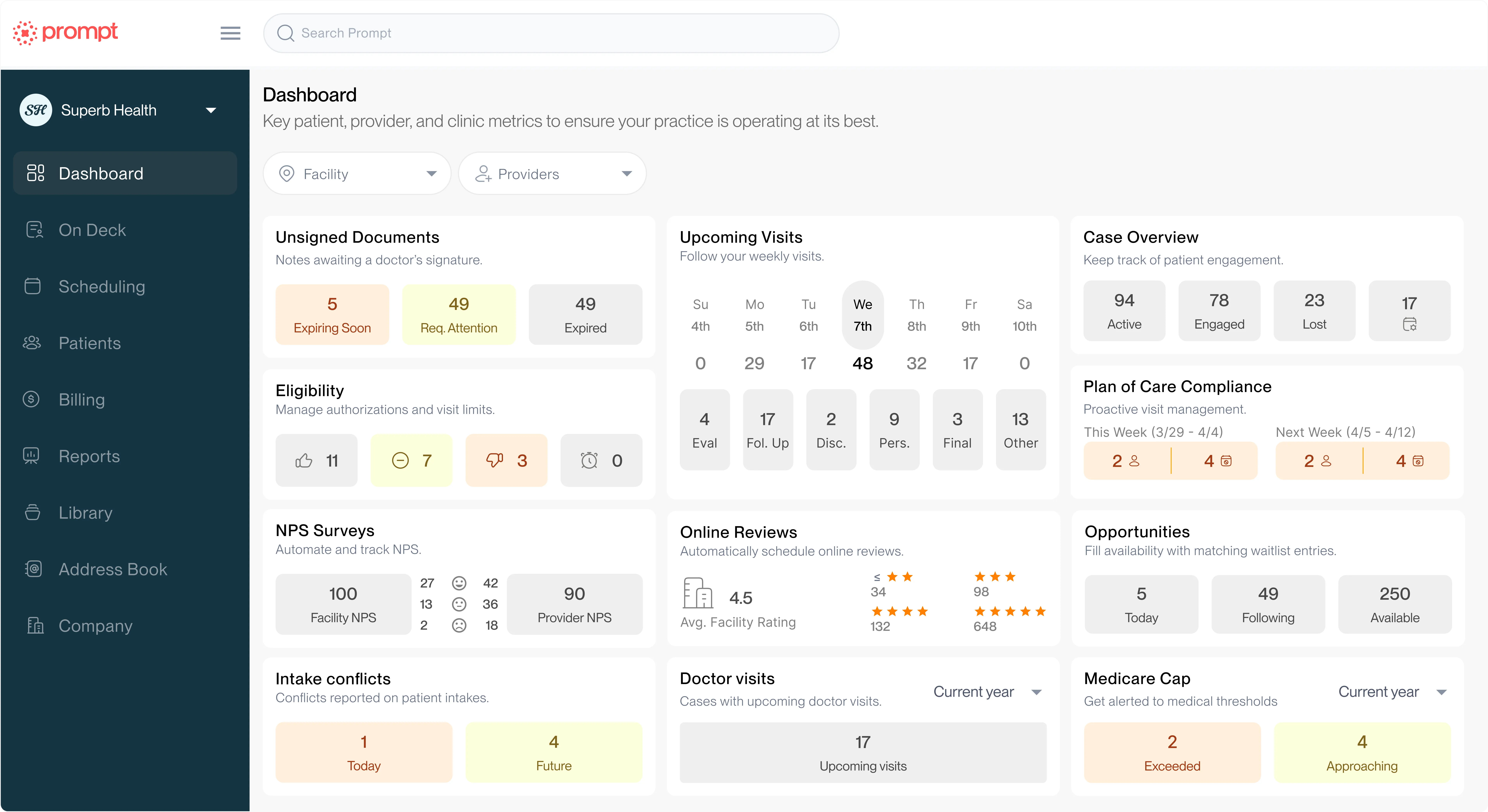See Prompt in action!


Discover what separates the fastest-growing rehab therapy practices from the rest. Prompt’s 2025 Practice Growth Survey reveals how top clinics use connected systems, automation, and data-driven operations to drive revenue, efficiency, and patient success.
Patient demand for rehab therapy isn’t slowing down—but running a profitable practice is harder than it should be. Shrinking margins, payer pushback, and staffing shortages are testing even the best operators.
So we asked 550 outpatient rehab therapy practices one question: how are some clinics still winning?
Short answer: the gap is real, but the playbook is repeatable. Roughly 8 in 10 clinics grew year-over-year, half topped 10%, and 1 in 5 hit 20%+ growth—well above the physical therapy industry’s projected ~4.6% CAGR. High performers aren’t getting lucky; they’re getting disciplined.
This report distills what they do differently—so you can do it, too.
Rehab therapy is operating in one of the toughest business climates in decades: reimbursement is flat, costs are up, and workflows are too manual. The strain lands on people first:
Yet demand is there—and the opportunity is big. Practices that modernize operations, align teams to data, and reduce clinician friction are proving you can grow and protect margins.
Roughly a third of practices now use automation tools like digital intake, smart scheduling, or automated billing, but only 1 in 5 are experimenting with AI beyond documentation. The gap shows in the human toll: nearly half of practice leaders said burnout is a moderate or major concern. The tools that could give time back to teams simply aren’t being adopted widely enough.
High-growth clinics (10%+ year-over-year revenue; “super-growth” at 20%+) face the same headwinds as everyone else. Their edge is operational: tighter schedules, cleaner handoffs, connected tools, and leaders who use data to make fast, fair decisions.
Below, three impact areas where the gains stack up—and exactly how to translate them to your clinic.
When growth strains capacity, most clinics add people or push harder. But the highest performers do the opposite.
They protect their teams by eliminating the work that causes burnout in the first place. Automation, smarter scheduling, and data-driven visibility reduce overload and help clinicians focus on care, not admin.
The goal: Build a sustainable growth engine by giving time back to your team and creating a culture where efficiency fuels well-being.
Key indicators to watch:
What winning clinics do
Winning clinics automate the work that drains time and morale.
They use AI and automation to handle intake, scheduling, claims checks, and documentation so clinicians can spend their energy where it matters most—on patient care. Their systems are unified, not pieced together, which means no double entry and fewer frustrating handoffs between departments. Leaders rely on real data to balance caseloads and prevent overload rather than guessing at capacity, and they back up those insights with clear, fair compensation structures that reward performance. By connecting efficiency and equity, these clinics are proving that profitability and well-being can grow together.
Why it matters
Fewer nights spent documenting = fresher clinicians and predictable throughput. And here’s the bridge to finance: when clinicians finish documentation within business hours, they can accept more visits during business hours—lifting margins without adding headcount.
Even strong demand doesn’t guarantee strong cash flow. Missed visits, slow claims, and disconnected tools drain revenue from the system. High-growth practices fix the foundation first—automating billing, optimizing scheduling, and shortening the path from completed visit to paid claim.
The goal: Turn consistency into predictability by tightening every step between care delivered and cash collected.
Key indicators to watch:
What winning clinics do
The top performers treat every open slot and every delayed claim as an opportunity to recover revenue. They use digital waitlists and automated outreach to fill same-day cancellations before the slot is lost, while AI-driven compliance and coding tools ensure claims go out clean on the first submission.
Their automation doesn’t stop at the front desk. It extends through intake, documentation, and billing, turning once-fragmented processes into a seamless flow. These practices also diversify their revenue streams by creating structured referral programs, optimizing self-scheduling, and exploring reimbursable programs like RTM to supplement traditional visits. The result is a faster, more predictable cash cycle and a business model that grows without adding overhead.
Why it matters
Predictable cash covers payroll and fuels reinvestment. Small daily gains, one more backfilled slot, a claim submitted hours sooner, all compound into materially higher monthly collections and margin.
Once schedules are reliably full and cashflow is steady, the next growth lever isn’t more volume—it’s better retention. Digital engagement turns that consistency into scale, extending efficiency beyond operations and into every patient touchpoint.
The goal: Grow faster with better margins by making the patient journey smooth and self-serve—from first contact to plan-of-care completion.
Key indicators to watch:
What winning clinics do
High-growth clinics make the patient journey easy and efficient from the first click to the final visit. They remove friction with digital intake, online scheduling, and automated reminders that keep visits on track without adding staff effort.
Where most clinics stop at basic reminders, top performers go further—treating engagement as a system, not a side task. They automate plan-of-care follow-ups, use data to identify at-risk patients, and re-engage those who drop off. With connected communication and smart automation, these clinics keep schedules full, outcomes stronger, and patients coming back.
Why it matters
Effortless engagement turns operational efficiency into real growth. The more consistent each step of the patient journey becomes, the more reliable the revenue. High-growth clinics don’t just communicate more. They close the loop faster, retain patients longer, and strengthen outcomes that drive referrals and reputation.
Only 1 in 5 clinics hit 20%+ growth—but their operating rhythm is teachable:
In short: Super-growth clinics run cleaner, automate faster, and reinvest gains in people—outpacing the industry’s ~4.6% CAGR by a mile.
This isn’t a demand problem; it’s an efficiency opportunity. High-growth clinics aren’t grinding harder. They’re eliminating wasted hours, connecting their tools, and using data as a management system (not just a scoreboard).
If you’re looking for the first moves:
Do those three things in that order, and growth stops being accidental. It becomes designed—and repeatable.
See what strategic growth looks like
Prompt’s unified platform helps clinics run more efficiently, align teams, and grow without breaking. When your ops hum, your people thrive—and the numbers follow.
Findings in this report are drawn from the 2025 Prompt Practice Growth Survey, a nationwide survey conducted to understand how outpatient rehab therapy practices are adapting and growing in today’s environment.
The survey collected responses between May 2025 and October 2025 from 550 clinic leaders, clinicians, and administrative staff across physical therapy, occupational therapy, and speech-language pathology settings. Respondents represented a range of practice sizes from single-location private clinics to multi-site regional groups, covering the entire U.S.
Participants were asked about key areas of operational performance, financial health, technology adoption, and workforce well-being. Responses were analyzed by year-over-year revenue growth rate, defining:
All data was self-reported and reviewed for completeness and consistency. Percentages have been rounded for clarity, and any interpretive commentary in this report is derived directly from trends observed in the survey data.
Help your practice grow
From intake to insights, Prompt is the all-in-one platform you need